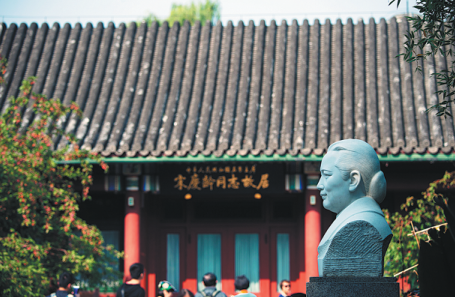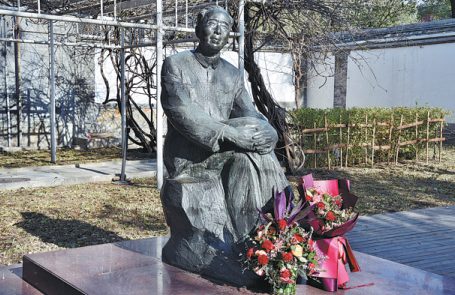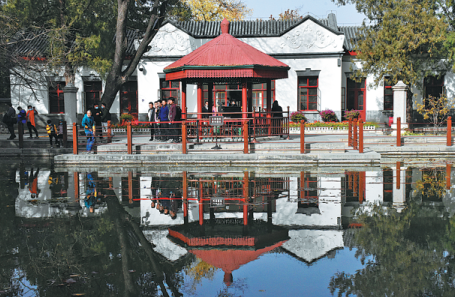At the center of a revolutionary past
A number of memorial sites and artifacts around Beijing detail its rich red history, Yang Feiyue reports.
Being the cultural center of the country, Beijing is rich in landmarks and artifacts of its revolutionary past.
In celebration of the 100th anniversary of the founding of the Communist Party of China, the Beijing Municipal Bureau of Culture and Tourism has launched more than 20 tourist routes that will take visitors through the history of the CPC before the founding of New China in 1949.
These routes cover the capital city's landmarks, cultural relics, memorial halls, mausoleums and scenic spots that carry these red elements.
Visitors can take a glimpse into the lives of martyrs who had made contributions to the nation's independence and development while enjoying the grandeur of Beijing's natural and urban landscapes.
Here are some of the highlights of red tourism in Beijing.
Honglou beginnings
Tourists can start their red tour at the Peking University Honglou in Dongcheng district. Honglou, or the red building, is a brick-wood structure established in 1918 and has been considered the origin of Chinese advancement. The May Fourth Movement started at Honglou, as a large number of people with lofty ideals learned about and accepted Marxism here. The former site of the Peking University's predecessor Imperial University of Peking, which was founded in 1898, is about a 10-minute walk away from Honglou. As the first comprehensive national university in modern Chinese history, it was established during a history of an unprecedented crisis for the Chinese nation.
Famous residences
Follow the footprints and glorious moments of several historical figures with visits to their former residences.
Guo Moruo (1892-1978), one of the greatest writers and poets in China's modern history, lived near Shichahai, Xicheng district. Born into a merchant family in Sichuan, Guo wrote many famous works that greatly contributed to maintaining the unity of the Chinese people during the War of Resistance Against Japanese Aggression (1931-45). He held a number of high-level government posts while continuing his literary creations. Guo is known for his historical plays on Cai Wenji and Empress Wu Zetian. Guo lived in his Shichahai courtyard residence for 15 years from November 1963 until his death. Many of his manuscripts, books and documents are still kept there. The ginkgo trees and peonies that Guo and his wife planted are still blossoming in the courtyard.
A 25-minute walk away from Guo's residence is Soong Ching Ling's former residence in the Houhai area. Soong was one of China's greatest philanthropists and wife of Sun Yat-sen, the father of modern China. She made many significant contributions to China's social and welfare causes during her lifetime. Soong's residence is filled with various plants and is surrounded by lakes and artificial mountains. She moved into the residence in 1963, and lived in the residence for 18 years until her passing in 1981.
Fragrant memories
Built in 1985, the December 9th Movement Memorial Pavilion is located in Haidian district and consists of three triangular kiosks. It recounts the 1935 patriotic student movement that broke out in Peiping (a former name for Beijing) when the Kuomintang forces suppressed a gathering of about 3,000 students who demonstrated to fight the Japanese invasion and save the nation. The movement later received support from more students in large and medium cities, and patriotic compatriots across the country. It sparked a new surge in the nationwide movement for the resistance against Japan. Visitors can visit the Shuangqing Villa at Fragrant Hills in Xiangshan Park. Mao Zedong and other leaders commanded the battle of crossing the Yangtze River at the villa, and discussed plans to construct the country. A large amount of work was done there for the founding of the People's Republic of China. At the villa, visitors can view the large number of cultural relics, photos and pictures on display detailing Mao's time at the villa. The Fragrant Memorial Hall nearby also helps visitors understand revolutionary history in this area through valuable exhibits, photos and videos.
Footsteps of martyrs
At the Yuanmingyuan Ruins in Haidian district, visitors can visit the mausoleum in memory of 47 martyrs killed on March 18, 1926, during a confrontation against armed military police ordered by Duan Qirui's warlord-led Beiyang government. Led by Li Dazhao, the demonstrators called for an end to all unequal treaties signed between China and foreign powers, in addition to expelling foreign ambassadors who issued an ultimatum demanding the Duan government destroy all defense establishments on the Taku Forts, which a Japanese warship bombed on March 12,1926. Worried that the situation would get out of hand, the Duan government ordered the oppression of the protesters.
After visiting the mausoleum, visitors can continue to follow the footsteps of more heroes and martyrs during the War of Resistance Against Japanese Aggression at the Heishanhu memorial park. Located at the Baiwang Mountain Forest Park, it was built to commemorate the martyrs who died during the battle of Heishanhu in 1937. The memorial park covers an area of more than 600 square meters and features inscriptions, sculptures and commemorative walls. Visitors can also enjoy hiking, the lush forest and fresh air at the Baiwang Mountain.
Civilian sacrifices
About 85 kilometers away from downtown Beijing, the Yuzishan Memorial for the War of Resistance Against Japanese Aggression is located beside the Jingdong Grand Canyon in northeastern Beijing's Pinggu district, with the continuous mountains making a charming natural backdrop. Covering an area of 400 square meters, the memorial displays precious historical pictures from the war of resistance. The memorial opened to the public in 1997.
The original site of the Jidong Base is another place worth visiting in the district. Soldiers and civilians waged a struggle against the Japanese invaders in the mountain and made countless sacrifices for victory. In July 1940, five Communist Party members established the district's first Party branch here. Under the CPC's leadership, the locals fought the Japanese invaders. The area was known as Unbeatable Yuzishan at that time.
Visitors should also not miss the Pingbei Anti-Japanese Martyrs Memorial Park sitting at the foot of Longqingxia Gorge in northwestern Beijing's Yanqing district. The park consists of a martyrs' cemetery, monument and memorial hall. There are also displays explaining the history of Pingbei's military and civilian resistance against the Japanese invasion from March 1933 to September 1945. In the district's Shatanggou village, visitors can view an exhibition that showcases the past years of the revolution. A 40-minute revolutionary documentary at the park offers visitors a deeper understanding of the historical battles.
Contact the writer at yangfeiyue@chinadaily.com.cn



















